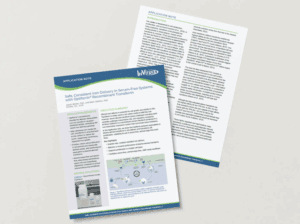- Home
- Safe, Consistent Iron Delivery in Serum-Free Systems with Optiferrin® Recombinant Transferrin
Safe, Consistent Iron Delivery in Serum-Free Systems with Optiferrin® Recombinant Transferrin
Published on 30 June 2025
Application Note
Authors: Jake Webber, Ph.D, Vice President of Process Development & Mark Stathos, PhD, Product Applications Scientist
InVitria, Inc., USA
Overview
Efficient iron delivery plays a critical role in maintaining cell health, supporting proliferation, and maximizing therapeutic productivity. However, serum-derived transferrin introduces variability, regulatory risk, and the potential for contamination.
This application note demonstrates how Optiferrin, a recombinant transferrin for iron delivery in serum-free media, provides a consistent and animal-origin-free alternative. It mirrors native transferrin biology and enables reliable performance in defined systems.
Through receptor-mediated endocytosis, Optiferrin actively delivers bioavailable iron and supports high-performance, xeno-free workflows across a broad range of cell types.
Key Findings
- Optiferrin shows functional equivalence to native transferrin in hybridoma proliferation.
- It enables efficient iron uptake via transferrin receptor-mediated endocytosis.
- The product is compatible with multiple cell types, including hybridomas, iPSCs, and MSCs.
- It supports scalable, regulatory-friendly biomanufacturing workflows.
Materials & Methods
Sp2/0 hybridoma cells (ATCC) were used to assess the functional activity of recombinant transferrin in serum-free conditions. These cells are commonly used in antibody production workflows and serve as a relevant model for evaluating proliferation performance.
- Base medium: DMEM/F12
- Initial supplements:
- GlutaMax™ (ThermoFisher Scientific) – a stabilized dipeptide form of L-glutamine
- 10 mM HEPES – for buffering capacity
- 10% fetal bovine serum (FBS) – used during cell expansion before the assay setup
Cells were maintained under standard conditions (37°C, 5% CO₂) prior to assay.
Transferrin Bioactivity Assay Setup
To evaluate Optiferrin’s performance as a recombinant transferrin for serum-free media, hybridoma cells were transitioned to chemically defined conditions:
- Serum removal: Cells were washed thoroughly with basal DMEM/F12 to eliminate residual serum and prevent carryover of serum-derived transferrin.
- Defined media supplementation: Fresh basal medium was supplemented with:
- 1 g/L recombinant human albumin (rHSA) – for osmotic balance and carrier function
- 10 mg/L recombinant human insulin – to support glucose uptake and growth
- 6.7 µg/L sodium selenite – an essential trace element for enzymatic activity
- 2 mg/L ethanolamine – a phospholipid precursor for membrane integrity
This defined supplementation mimics standard serum-free formulations used in production environments.
Transferrin Treatment:
Cells were seeded into 96-well plates and treated with either:
- Serum-derived human transferrin (control group)
- Optiferrin – InVitria’s recombinant transferrin for iron delivery in serum-free media
- Dosage range: 0.1 to 10 mg/L
- Replicates: Triplicate wells per concentration
- Incubation period: 72 hours under standard growth conditions
- Endpoint: Viable cell concentration was assessed using trypan blue exclusion and manual or automated cell counting.
Featured Solution
Optiferrin – Recombinant Transferrin for Iron Delivery in Serum-Free Media
 Optiferrin is a recombinant, animal-origin-free human transferrin designed to replace plasma-derived transferrin in chemically defined media. It enables safe, efficient iron delivery via transferrin receptor-mediated endocytosis and supports robust proliferation across a wide range of mammalian cell types. Optiferrin eliminates the risk of adventitious agents and lot-to-lot variability associated with serum-derived transferrin, helping biomanufacturers transition to scalable, xeno-free workflows for cell therapy, gene therapy, and vaccine production.
Optiferrin is a recombinant, animal-origin-free human transferrin designed to replace plasma-derived transferrin in chemically defined media. It enables safe, efficient iron delivery via transferrin receptor-mediated endocytosis and supports robust proliferation across a wide range of mammalian cell types. Optiferrin eliminates the risk of adventitious agents and lot-to-lot variability associated with serum-derived transferrin, helping biomanufacturers transition to scalable, xeno-free workflows for cell therapy, gene therapy, and vaccine production.
Download the Full Application Note

The following content is gated. Please, subscribe to open access to it.